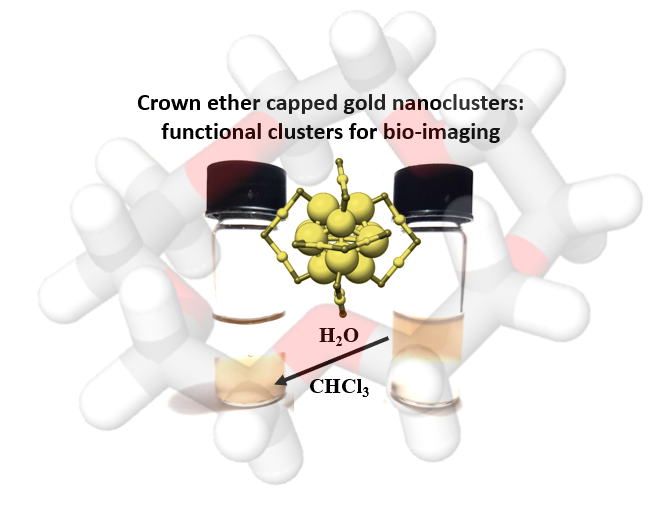YOUR BROWSER IS OUT-OF-DATE.
We have detected that you are using an outdated browser. Our service may not work properly for you. We recommend upgrading or switching to another browser.
"Gold nanoclusters capped with crown ethers as smart markers with enhanced functionality for two-photon bio-imaging" PRELUDIUM project, financed by National Science Centre in Poland (2023-2025)
Main coordinator: PhD Eng. Patryk Obstarczyk
 The project is aimed at the design, synthesis, and physicochemical characterization of a novel and near-infrared (NIR) fluorescent atomically-precise nanoclusters (APNCs) capped with supramolecular ligands: crown ethers (CEs). We introduce CEs host-guest functionality into atomically-precise nano- chemistry field to achieve control over cluster hydrophobicity for potential application in two-photon bioimaging. We will comprehensively investigate host guest functionality (i.e. selective ion complexation) and crown ether macrocyclic molecule size influence on clusters' physiochemistry. Moreover, a quantitative description of nanoclusters' linear and nonlinear optical (NLO) properties will be executed to evaluate their mileage in two-photon microscopy. Due to the ultra-small sizes (< 2nm), the quantum nature of APNCs manifests itself in UV-Vis absorption spectra. The energy levels are distinct for specific cluster sizes, non-plasmonic, and extremely sensitive to changes (even at the scale of a single gold atom). Unique properties of this group of nanoparticles provide broad spectra of functionality, transgressing the possibilities available for plasmonic nanostructures or organic dyes, especially if considered as multimodal markers. Moreover, their photoluminescence may be tuned to the NIR wavelengths being beneficial for bioimaging. APNCs' chemical composition can be strictly controlled and they were proven to be applicable in vivo imaging. In addition, APNCs ligand functionality plays a crucial role upon interaction with biosystems, therefore therapeutical properties may be developed. Our nanomaterials are designed as probes with enhanced functionality, i.e. cation governed control over their hydrophobicity (thus designed surface affinity). Wet-chemistry synthesis methods (e.g. modified Schmid and Burst methods) will be applied to directly synthesize atomically-precise nanoclusters of desired optical properties. Additionally, the controlled ligand exchange process will be used to obtain hetero-ligand systems. Reaction conditions will be optimized to maintain an atomically-precise clusters core. Purified clusters (e.g. by HPLC method) will be physiochemically characterized, including the quantitative description of their NLO properties (e.g. by z-scan or two-photon fluorescence excitation method) and hydrophobicity modulation. Preliminary research confirmed that nanoclusters capped with CEs have inherited ligand host-guest functionality and are prone to interact with small cations (H3O+). We have achieved efficient modulation of gold nanoclusters hydrophobicity confirmed by cluster phase transfer from aqueous to organic solution dependent on cation concentration. The bright NIR fluorescence was also confirmed. The number of core atoms cannot be unambiguously determined yet, clusters were 1.7 nm in diameter. As a result of this project, several publications indexed in the Web of Science and JCR database are planned. Research in the framework of this project contributes to the understanding of nanocluster formation in the presence of supramolecular ligands, core susceptibility to functionalization, and CEs ligands' influence on clusters' NLO properties. This research is pioneering in the controlled modulation of APNCs hydrophobicity and introduces supramolecular chemistry into the field of atomically-precise nanoclusters.
The project is aimed at the design, synthesis, and physicochemical characterization of a novel and near-infrared (NIR) fluorescent atomically-precise nanoclusters (APNCs) capped with supramolecular ligands: crown ethers (CEs). We introduce CEs host-guest functionality into atomically-precise nano- chemistry field to achieve control over cluster hydrophobicity for potential application in two-photon bioimaging. We will comprehensively investigate host guest functionality (i.e. selective ion complexation) and crown ether macrocyclic molecule size influence on clusters' physiochemistry. Moreover, a quantitative description of nanoclusters' linear and nonlinear optical (NLO) properties will be executed to evaluate their mileage in two-photon microscopy. Due to the ultra-small sizes (< 2nm), the quantum nature of APNCs manifests itself in UV-Vis absorption spectra. The energy levels are distinct for specific cluster sizes, non-plasmonic, and extremely sensitive to changes (even at the scale of a single gold atom). Unique properties of this group of nanoparticles provide broad spectra of functionality, transgressing the possibilities available for plasmonic nanostructures or organic dyes, especially if considered as multimodal markers. Moreover, their photoluminescence may be tuned to the NIR wavelengths being beneficial for bioimaging. APNCs' chemical composition can be strictly controlled and they were proven to be applicable in vivo imaging. In addition, APNCs ligand functionality plays a crucial role upon interaction with biosystems, therefore therapeutical properties may be developed. Our nanomaterials are designed as probes with enhanced functionality, i.e. cation governed control over their hydrophobicity (thus designed surface affinity). Wet-chemistry synthesis methods (e.g. modified Schmid and Burst methods) will be applied to directly synthesize atomically-precise nanoclusters of desired optical properties. Additionally, the controlled ligand exchange process will be used to obtain hetero-ligand systems. Reaction conditions will be optimized to maintain an atomically-precise clusters core. Purified clusters (e.g. by HPLC method) will be physiochemically characterized, including the quantitative description of their NLO properties (e.g. by z-scan or two-photon fluorescence excitation method) and hydrophobicity modulation. Preliminary research confirmed that nanoclusters capped with CEs have inherited ligand host-guest functionality and are prone to interact with small cations (H3O+). We have achieved efficient modulation of gold nanoclusters hydrophobicity confirmed by cluster phase transfer from aqueous to organic solution dependent on cation concentration. The bright NIR fluorescence was also confirmed. The number of core atoms cannot be unambiguously determined yet, clusters were 1.7 nm in diameter. As a result of this project, several publications indexed in the Web of Science and JCR database are planned. Research in the framework of this project contributes to the understanding of nanocluster formation in the presence of supramolecular ligands, core susceptibility to functionalization, and CEs ligands' influence on clusters' NLO properties. This research is pioneering in the controlled modulation of APNCs hydrophobicity and introduces supramolecular chemistry into the field of atomically-precise nanoclusters.